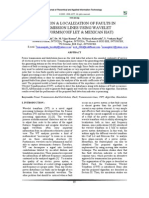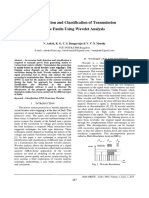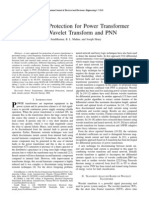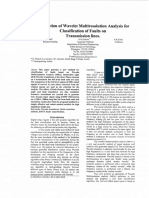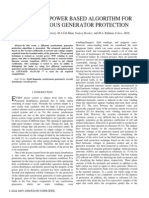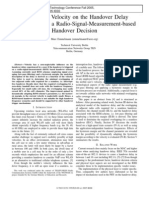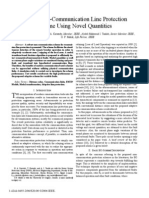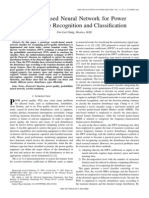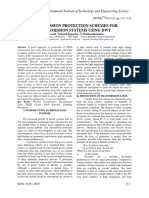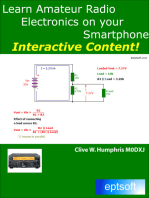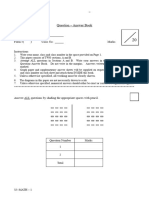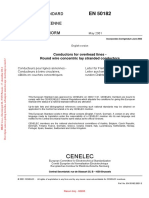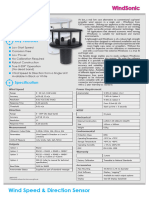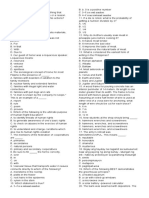Novel Technique For Fault Location Estimation On Parallel Transmission Lines Using Wavelet
Novel Technique For Fault Location Estimation On Parallel Transmission Lines Using Wavelet
Uploaded by
Rachana MeenaCopyright:
Available Formats
Novel Technique For Fault Location Estimation On Parallel Transmission Lines Using Wavelet
Novel Technique For Fault Location Estimation On Parallel Transmission Lines Using Wavelet
Uploaded by
Rachana MeenaOriginal Title
Copyright
Available Formats
Share this document
Did you find this document useful?
Is this content inappropriate?
Copyright:
Available Formats
Novel Technique For Fault Location Estimation On Parallel Transmission Lines Using Wavelet
Novel Technique For Fault Location Estimation On Parallel Transmission Lines Using Wavelet
Uploaded by
Rachana MeenaCopyright:
Available Formats
Novel technique for fault location estimation on parallel
transmission lines using wavelet
Hosung Jung
a,
*
, Young Park
a
, Moonseob Han
a
, Changmu Lee
a
,
Hyunjune Park
a
, Myongchul Shin
b
a
Signaling and Electrical Engineering Research Department, Korea Railroad Research Institute, #374-1, Woulam-Dong, Uiwang-City,
Kyunggi-do 437-050, Republic of Korea
b
School of Information and Communication Engineering, Sungkyunkwan University, 300, Chunchun-dong, Jangan-gu, Suwon,
Kyunggi-do 440-746, Republic of Korea
Received 22 March 2005; received in revised form 29 March 2006; accepted 15 May 2006
Abstract
In this paper, the novel technique for fault location has been investigated on parallel transmission lines using wavelet. Using this tech-
nique, we propose two parts for accurate, rapid fault detection and fault location estimation regardless of mutual coupling between par-
allel lines. The rst part is fault detection and extraction of the fundamental signal using wavelet transform. The second part is fault
location estimation using least square error method independent of fault resistance, and the remote in feed, etc. The results of extensive
simulation showed that it successfully protected the parallel transmission line compared to the traditional techniques more quickly and
reliably.
2006 Elsevier Ltd. All rights reserved.
Keywords: Fault location estimation; Least square error method; Parallel transmission lines; Wavelet transform
1. Introduction
Parallel transmission lines have been utilized in power
system to improve reliability and security of electrical
energy transmission. However, a practical setting for the
general transmission line protection causes mal-operation
of relay due to the mutual coupling between parallel lines
[1,2]. The ability of protection relay considering mutual
coupling is aected by fault resistance, load current, and
source impedance and so on. Especially the reliability of
protection decreases seriously under high resistance faults.
So technique exclusive of mutual coupling inuence must
be studied for the accurate and rapid fault detection and
fault location estimation [3,4].
This paper proposes an improved technique for the Par-
allel transmission line protection. It consists of two parts,
the rst part is fault detection and extraction of the funda-
mental signal using wavelet transform and the second part
is fault location estimation using least square error method
independent of fault resistance, and the remote in feed, etc.
Extensive simulation is performed to evaluate the proposed
algorithm using EMTP (electromagnetic transient pro-
gram). The proposed algorithm is programmed by MAT-
LAB and compared to the traditional protection
techniques. In conclusion, it can protect the parallel trans-
mission line compared to the traditional techniques more
quickly and reliably.
2. Fault detection technique using wavelet transform
2.1. Extraction of characteristics using wavelet transform
Wavelet transform is possible to extract information in
time domain by decomposing the transient signal with
short scale of window for high frequency band while with
0142-0615/$ - see front matter 2006 Elsevier Ltd. All rights reserved.
doi:10.1016/j.ijepes.2006.05.002
*
Corresponding author. Fax: +82 31 4605459.
E-mail address: hsjung@krri.re.kr (H. Jung).
www.elsevier.com/locate/ijepes
Electrical Power and Energy Systems 29 (2007) 7682
long window scale for low frequency band using scale and
shift technique, contrary to Fourier transform [5]. Accord-
ingly, it is eective for analyzing of transient signal contain-
ing harmonics by using discrete wavelet transform as
shown in (1):
D
a;b
1
a
m
0
_
Sn W
k na
m
0
a
m
0
_ _
1
where a
m
0
is variable for scale, na
m
0
is variable for shift, and
1=a
m
0
is energy normalization component to keep the same
scale as mother wavelet.
The important elements in analyzing transient signal
using wavelet transform are to select mother wavelet and
to decide the number of multiple decomposition steps. As
for mother wavelets, Harr, Daubechies, Biorthogonal,
Coiets, and Symlets may be listed, of which forms and
properties are dierent depending on their types, accord-
ingly optimum mother wavelet should be selected compar-
ing the abilities of removing harmonics as well as extracting
characteristics from fault signals. In addition, the number
of decomposition steps is inuenced from the sampling fre-
quency of original signal. In the rst decomposition step, it
is decomposed into D1 component of high frequency band
and A1 component of low frequency band. The frequency
band of D1 component is fs/2fs/4 Hz, and A1 component
is fs/40 Hz. In the second decomposition step, A1 compo-
nent extracted from the rst decomposition step is again
decomposed D2 component of high frequency band and
A2 component of low frequency band. The frequency band
of D2 component is fs/4fs/8 Hz and the frequency band of
A2 component is fs/80 Hz band. As the signal of the
desired component can be extracted via repetitious decom-
position as like as this, number of decomposition steps
should be decided by comparing the scale of sampling fre-
quency with that of the frequency component of desired
signal. Fig. 1 shows the component extracted via wavelet
transform in accordance with sampling frequency, as well
as the frequency bands of the respect components.
In this paper, db5 which has 5 nodal points of daube-
chies was selected for mother wavelet. Because mother
wavelet db5 clearly classies the magnitude of D1 compo-
nent of fault and sound phases compared with other
mother wavelets, and it is superior in the ability of harmon-
ics elimination. And, 3840 [Hz] (64 sample/cycle) was
selected for sampling frequency and A3 component of
low frequency domain and D1, D2, D3 components of high
frequency domain are extracted through the three step
decomposition. Fig. 2 shows the components acquired by
wavelet transform and the frequency domain of compo-
nents in one line ground fault. From the result of Fig. 2,
we can see that, when fault occurs, D1 component is
response the most sensitive, and A3 component is removed
the harmonics on fault signal. And to see the frequency
band of all components, it may be said that D1 component,
the most high frequency wave component is decomposed to
1920960 Hz band, D2 component to 960480 Hz, D3
component to 480240 Hz, and A3 component, the most
low frequency component to 240 Hz DC frequency band.
2.2. Fault detection technique
As D1 component extracted by wavelet transform
changed the most under transient state, fault detection
can be detected using D1 component. However, as D1
component of sound phases is also changed depending on
HF
LF
HF
LF
HF
LF
f(x)
D1
D2
Dj
Aj
A1 A2
QMF1 QMF2 QMFj
fs / 2
fs / 4
fs / 8
0[Hz]
fs / 2
fs / 2
j+1
j
Fig. 1. Frequency band of wavelet transform.
-9x10
3
0
9x10
3
-20
0
20
-10
0
10
-9x10
3
0
9x10
3
-60
0
60
fault : 45.8ms
A3
Time [ms]
D2
M
a
g
n
i
t
u
d
e
D1
33.3 16.7 66.7 50.0 100.0 83.3 133.3 116.7
33.3 16.7 66.7 50.0 100.0 83.3 133.3 116.7
33.3 16.7 66.7 50.0 100.0 83.3 133.3 116.7
33.3 16.7 66.7 50.0 100.0 83.3 133.3 116.7
33.3 16.7 66.7 50.0 100.0 83.3 133.3 116.7
Fault Signal
D3
(a) Wavelet transform result
0 240 480 960 1200 1440 1680 1920
0
5x10
5
1x10
6 0 240 480 720 960 1200 1440 1680 1920
0
150 0
300 0
450 0
0 240 480 720 960 1200 1440 1680 1920
0
500
100 0
150 0
0 240 480 720 960 1200 1440 1680 1920
0
200
400
600
800
Frequence Analysis
A 3
G
A
I
N
Frequence [Hz]
D 3
D 2
D 1
(b) Frequency analysis of component
720
Fig. 2. Three step wavelet transform and frequency analysis.
H. Jung et al. / Electrical Power and Energy Systems 29 (2007) 7682 77
fault occurrence condition, it may bring about unwanted
operation if fault is detected simply using only the change
of D1 component. Accordingly, after calculating the ratio
of scales of D1 components among the respect phases, if
the ratio exceeds in a certain value, fault was detected.
For fault detection, rst, if the summation of absolute
value of D1 component for one cycle exceeds in a
t
such
as (2), which is regarded as transient condition. Here, a
t
is a parameter for detecting transient signals and set 100
not to operate in a normal switching condition. Under
transient condition, after comparing the magnitude of D1
component of one phase with those of the other phases
as shown in (3), if the ratio exceed in a
f
simultaneously,
which is regarded as fault phase. Here a
f
is a parameter
for detecting fault phase nally and set 0.85 considering
the margin of D1 magnitude between fault phases:
1 cycle
jD1j > a
t
) Transient 2
1 cycle
jD1
R
j
1 cycle
jD1
S
j
> a
f
_ _
&
1 cycle
jD1
R
j
1 cycle
jD1
T
j
> a
f
_ _
) Fault 3
Once fault phase is detected, ground fault or short fault
are distinguished by using the scale of zero sequence cur-
rent as shown in (4):
I
0 rms
> a
0
) Ground Fault
< a
0
) Short Fault
4
In parallel transmission lines, if one transmission line
occurs ground fault, sound transmission line also has an
occurrence of similar deviation due to zero sequence
mutual coupling. From this, as it is concerned about
unwanted operation of relay of sound transmission line,
the ratio of zero sequence currents of own transmission line
and the other transmission line was calculated as shown in
(5), to prevent the relay of sound transmission line from
unwanted operation:
I
0frms
I
0srms
> a
fs
) Fault Line
< a
fs
) Sound Line
5
Fig. 3 is a owchart for fault detection and fault type
classication using wavelet transform.
3. Fault location estimation technique
Once fault phase is detected, it is very important to nd
out the fault location rapidly. To do this, a case is pre-
sented as shown in Fig. 4, i.e., an occurrence of A phase
one line ground fault of F line on parallel transmission line,
both ends of which have power supplies. Eq. (6) is resulted
from expressing it in a form of dierential equation by
decomposing to symmetric components after simplifying
the line from P bus to fault point as a concentrated line
model [6,7]:
V
ap
R
1
I
ap
K
r
I
ap0
K
rm
I
s0
L
1
dI
ap
dt
K
l
dI
ap0
dt
K
lm
dI
s0
dt
_ _
R
f
I
f
6
where K
r
= (R
0
R
1
)/R
1
, K
l
= (L
0
L
1
)/L
1
, K
rm
= R
m0
/
R
1
, K
lm
= L
m0
/L
1
, and I
S0
is zero sequence current of
sound line. From the above equation, the values that can
be measured on relay are V
ap
, I
ap
, I
p0
, and I
s0
. Also the val-
ues that should be calculated for estimating fault location
are R
1
, L
1
, and R
f
. Therefore, fault point current (I
f
) should
be estimated to calculate unknown value.
For this, an equation was derived using zero sequence
circuit in one line ground fault as shown in Fig. 5. Zero
sequence circuit does not exist before fault, and the inu-
ence from load do not aect on fault current since load
component is not connected even after fault occurs,
Fig. 3. Flowchart of fault detection and types classication.
Zs
Zf Zf
Zm
Vap
Vp Vq
Zp0
Zp1
Zp2
Zq0
Zq1
Zq2
Q P
x 1 - x
If
Rf
Iap Iaq
Vf
S Line
F Line
Fig. 4. Circuit of one line ground fault.
78 H. Jung et al. / Electrical Power and Energy Systems 29 (2007) 7682
accordingly it is possible to estimate fault point current
accurately.
To remove the fault current in-owing from Q bus, Eq.
(7) shows fault current in-owing to F point in the fault
line, while expressing it in voltage equation for sound line
and fault line will result in (8), accordingly two equations
may be expressed:
I
f0
I
ap0
I
aq0
7
I
s0
Z
s0
Z
m0
1 xZ
f0
Z
m0
I
aq0
xZ
f0
Z
m0
I
ap0
0 8
From the above equations, the fault point current will be
expressed as like as (9) by removing I
aq0
, inow current
of remote end:
I
f0
Z
m0
Z
s0
I
ap0
Z
m0
Z
f0
I
s0
1 xZ
m0
Z
f0
9
Assuming that parallel transmission lines use the same
line, the zero sequence impedance of the two lines is
Z
f0
= Z
s0
, and expressing I
f
, fault point current as symmet-
ric component will be I
f
= 3I
f0
. Therefore, Eq. (9) can be
changed (10) if it is expressed only with signals that can
be measured at relay:
I
f
3 I
f0
3
I
ap0
I
s0
1 x
10
In this equation, since fault distance is also unknown value,
expanding it by substituting it to Eq. (6) will express un-
known term as are R
1
, L
1
and R
f
/(1 x). To estimate un-
known value using least square error method, a matrix can
be expressed as shown in (11), and unknown matrix can be
estimated using pseudo-inverse matrix as shown in (12):
yk Ak xk a
1
ka
2
ka
3
k xk
yk V
ap
k
11
where,
xk R
1
kL
1
k
R
f
1 x
k
_ _
T
a
1
k I
ap
k K
r
I
ap0
k K
rm
I
s0
k
a
2
k
I
ap
k
dt
K
l
dI
ap0
k
dt
K
lm
dI
s0
k
dt
a
3
k 3 I
ap0
k I
s0
k
xk Ak
T
Ak
1
Ak
T
yk 12
4. Results of simulation
4.1. Model system
The model system of parallel transmission lines has
400 kV sources of two ends and the length of entire line
is 60 km, as shown in Fig. 6 and system parameters are
shown Table 1. The system was modeled using EMTP
(Electromagnetic Transient Program), and fault data was
extracted by simulating a various operating conditions
and faults. The model system was simulated with sampling
frequency of 3840 Hz, i.e., 64 samples per one cycle [8].
4.2. Fault detection result
Fig. 7 shows D1, D2, D3 components, high frequency
signal and A3 component, low frequency signal by three
steps decomposing the voltage wave forms of A phase
one line ground fault that occurred on fault angle of 90.
Fault signal is mixed with harmonics, and we can see that
D1 component shows the most sensitive reaction at fault
occurrence and that for A3 component, the harmonics is
removed on fault signal.
Fig. 8 shows the result of fault detection using D1 com-
ponent that is extracted by wavelet transform. Fig. 8(a)
shows D1 component of ground fault and the change of
summation of D1 component during one cycle for fault
detection, and Fig. 8(b) shows the result from comparison
of the scale of D1 component with those of other phases
for fault detection. Although the changes of D1 compo-
nents are shown in both of fault phase and sound phases
when fault occurs, comparing the summations of the abso-
lute values of the respect phases with each other will present
V
a0
V
p0
I
ap0
+ I
s0
x Z
m0
I
ap0
x (Z
f0
- Z
m0
)
I
s0
Z
s0
- Z
m0
I
aq0
(1 - x) (Z
f0
-Z
m0
)
I
aq0
- I
s0
(1 - x) Z
m0
I
f
0
R
f
P Q
x 1 - x
Fig. 5. Zero sequence circuit of one line ground fault.
VP P
fault
VQ Q
400 10 [kV]
60[km]
400 0 [kV]
Fig. 6. Parallel transmission lines model system.
Table 1
System parameters
System R L C [lF/km]
Source
impedance
[X]
P Zero sequence 23.459 108.31
Positive sequence 8.561 20.241
Q Zero sequence 17.530 70.795
Positive sequence 8.360 15.570
Line
impedance
[X/km]
Zero sequence 0.1510 1.1655 0.0009
Positive
sequence
0.0134 0.3144 0.0017
Mutual zero
sequence
0.0458 0.2504 0.0012
H. Jung et al. / Electrical Power and Energy Systems 29 (2007) 7682 79
that the summation of absolute values of D1 component of
A phase is far more bigger than the scale of B, C phases.
Therefore, fault can be detected accurately by compar-
ing the ratio of D1 components of the respect phases.
Setting value for fault detection was set to 0.85 by compar-
ing the ratios of D1 components of fault phase and sound
phase depending on fault distance and fault inception
angle.
Table 2 shows fault detection time using wavelet trans-
form. Fault signal was generated after the fault condition
was kept during 8 samples (2.08 [ms]) in order to prevent
from unwanted operation due to the temporary change
of D1 component. More rapid fault detection was possible
as harmonic components were much contained in 90 fault
in compare to 0 fault. But, fault detection was possible
within up to 5.21 ms to all fault conditions.
Fig. 9 is to compare the scales of zero sequence currents
of fault line and sound line depending on fault distance in
case fault inception angle is 0.
In case of fault line, the more farther fault distance is,
the smaller zero sequence current is gradually, while the
scale of zero sequence current in sound line is the smallest
on the point where the fault distance is 60%, due to the
inuence of zero sequence mutual coupling. In case of
ground fault, fault line and sound line were accurately
classied by comparing the scales of zero sequence cur-
rents of both circuits, and the setting value then was set
to 1.0.
4.3. Fault location estimation result
Fig. 10 shows the result of estimating fault location
using A3 component of low frequency domain. Within
1 cycle or so after fault occurrence, fault distance was accu-
rately converged to 1.888 X for 10% location and con-
verged to 16.57 X for 90%.
Fig. 11 shows the comparison of errors on fault location
estimation due to the mutual coupling. In case of consider-
ing mutual coupling there is an error up to 2% but the case
of not considering mutual coupling it could be known that
there is an error up to over 10%.
Table 3 shows the time converging to within 1% of
actual fault location depending on fault distance when fault
resistance is 0 X. In general, it may be said that the nearer
fault distance is, the faster it converges, which converges to
within 15.89 ms in case of 0 fault while to within 20.31 ms
in case of 90 fault.
Table 4 is to show the inuence of fault resistance in esti-
mating fault location, where the fault resistances are
increased to 1, 5, 10, 30, 50, 100, and 200 X, to show esti-
mation impedances. Fault location is 50% of the entire
length; resistance is 0.402 X; and reactance is 9.432 X.
-4
0
4
-2
0
2
-1
0
1
-4
0
4
-3
0
3
Time [ms] fault : 45.8ms
A3
D2
M
a
g
n
i
t
u
d
e
[
x
1
0
5
]
D1
Fault Signal
D3
33.3 16.7 66.7 50.0 100.0 83.3 133.3 116.7
33.3 16.7 66.7 50.0 100.0 83.3 133.3 116.7
33.3 16.7 66.7 50.0 100.0 83.3 133.3 116.7
33.3 16.7 66.7 50.0 100.0 83.3 133.3 116.7
33.3 16.7 66.7 50.0 100.0 83.3 133.3 116.7
Fig. 7. Output of the wavelet transform.
-100
0
100
-100
0
100
-100
0
100
Time [ms]
D1
Sum of D1
C Phase
D1
S
u
m
m
a
t
i
o
n
o
f
D
1
B Phase
M
a
g
n
i
t
u
d
e
o
f
D
1
33.3 0.0 100.0 66.7
33.3 0.0 100.0 66.7
33.3 0.0 100.0 66.7
Sum of D1
D1
Sum of D1 A Phase
-2000
0
2000
-2000
0
2000
-2000
0
2000
(a) D1 component and summation
-2
-1
0
1
2
-2
-1
0
1
2
-4
0
4
Time [ms]
D1C/D1B D1C/D1A
D1A/D1B, D1A/D1C
C Phase
B Phase
A Phase
T
r
i
p
s
i
g
n
a
l
R
a
t
i
o
41.7 58.3 50.0
----- : Setting Value : 0.9
D1B/D1C D1B/D1A
fault detection time : 52.1 [ms]
41.7 58.3 50.0
41.7 58.3 50.0
0
1
2
0
1
2
0
1
2
(b) D1 component ratio and fault detection
Fig. 8. Result of fault detection (A phase ground fault).
Table 2
Fault detection time [ms]
Phase angle Fault distance (%)
10 20 30 40 50 60 70 80 90
0 [deg] 2.60 3.65 3.65 3.65 4.69 4.95 5.21 3.65 3.65
90 [deg] 2.08 2.08 2.08 2.08 2.08 2.08 2.08 2.08 2.08
80 H. Jung et al. / Electrical Power and Energy Systems 29 (2007) 7682
From the above result, the bigger the scale of fault resis-
tance is, the more fault point estimation error is big, but
generally, fault location could be estimated regardless of
the magnitude of fault resistance.
5. Conclusion
In this paper, the fault detection technique using wavelet
transform and the fault location estimation technique using
least square error method were presented for the protection
of parallel transmission lines. Fault was detected rapidly
within 1 cycle by using D1 component that had been
extracted by wavelet transform, and fault location estima-
tion was improved by using A3 component of which har-
monics had been removed. And equation using zero
sequence circuit was presented to exclude the inuence of
fault resistance, and fault location was accurately estimated
within 1.5 cycles after fault using least square error method.
References
[1] Sheng LB, Elangovan S. A fault location method for parallel
transmission lines. Electr Power Energy Syst 1999;21:2539.
-1.78
1.89
5.56
9.23
12.90
16.57
20.24
23.91
27.58
Time [ms]
66.8 62.6 58.4 54.2 50.0 45.8
Fault impedace: 0.189 []/1 [%]
90[%]
70[%]
50[%]
30[%]
10[%]
F
a
u
l
t
i
m
p
e
d
a
n
c
e
[
]
Fig. 10. Fault impedance to the fault distance.
0 10 20 30 40 50 60 70 80 90 100
0
2
4
6
8
10
12
14
16
Fault location [%]
Compensation I
m0
No compensation I
m0
E
r
r
o
r
r
a
t
i
o
[
%
]
Fig. 11. Error to the compensation of mutual coupling.
0 10 20 30 40 50 60 70 80 90 100
0.0
0.4
0.8
1.2
- - - : Setting value : 1.0
I
s
/ I
f
Fault distance [%]
R
a
t
i
o
0 10 20 30 40 50 60 70 80 90 100
0
5
10
15
(92)
I
f
/ I
s
Fig. 9. Ratio of the zero sequence current to the fault distance.
Table 3
Convergence speed to the fault distance [ms]
Phase
angle
Fault distance (%)
10 20 30 40 50 60 70 80 90
0 [deg] 7.29 8.85 8.85 8.07 8.07 10.04 13.28 15.89 11.72
90 [deg] 9.64 14.06 13.54 15.10 13.02 19.01 20.31 19.27 19.01
Table 4
Estimation error to the fault resistance
Estimated value Fault resistance (X)
1 5 10 30 50 100 200
Resistance 0.245 0.590 0.506 0.683 0.646 0.490 0.530
Reactance 9.379 9.364 9.372 9.351 9.345 9.354 9.347
Error [%] 0.310 0.307 0.293 0.345 0.387 0.393 0.419
H. Jung et al. / Electrical Power and Energy Systems 29 (2007) 7682 81
[2] McLaren PG, Fernando I, Liu H, Dirks E, Swift GW. Enhanced
double circuit line protection. IEEE Trans Power Deliver 1997;12(3):
11008.
[3] Zhang Q, Zhang Y, Song W, Yu Y. Transmission line fault location
for phase-to-earth fault using one-terminal data. IEE Proc-Gener
Transm Distrib 1999;146(2):1214.
[4] Liao Y, Elangovan S. Digital distance relaying algorithm for rst-zone
protection for parallel transmission lines. IEE Proc-Gener Transm
Distrib 1998;145(5):5316.
[5] Misiti M. Wavelet toolbox users guide. MathWorks; 1996.
[6] Djuric MB. Time domain solution of fault distance estimation and
arcing fault detection on overhead lines. IEEE Trans Power Deliver
1999;14(1):607.
[7] Radojevic ZM, Terzija VV, Djuric MB. Numerical algorithm for
overhead lines arcing faults detection and distance and directional
protection. IEEE Trans Power Deliver 2000;15(1):317.
[8] EMTP User Group. Alternative transients program (ATP) rule book.
Canadian/American EMTP User Group; 1992.
82 H. Jung et al. / Electrical Power and Energy Systems 29 (2007) 7682
You might also like
- Iec 60085 - 1984Document10 pagesIec 60085 - 1984patagonik1No ratings yet
- Wavelet-Based Transmission Line Fault Detection and ClassificationDocument6 pagesWavelet-Based Transmission Line Fault Detection and ClassificationMohit Kumar ChowdaryNo ratings yet
- 10 1049@iet-Gtd 2011 0592Document12 pages10 1049@iet-Gtd 2011 0592Anonymous vLerKYANo ratings yet
- Wavelet Feature Based Fault Detection and Classification Technique For Transmission Line ProtectionDocument7 pagesWavelet Feature Based Fault Detection and Classification Technique For Transmission Line ProtectionGRD JournalsNo ratings yet
- New Method of Power Swing Blocking For Digital Distance ProtectionDocument8 pagesNew Method of Power Swing Blocking For Digital Distance ProtectionJohari Zhou Hao LiNo ratings yet
- Detection and Localizartion of Faults in Transmission LinesDocument6 pagesDetection and Localizartion of Faults in Transmission LinesKarina PulgarNo ratings yet
- Experimental Investigations On Multi-End Fault Location System Based On Current Traveling WavesDocument6 pagesExperimental Investigations On Multi-End Fault Location System Based On Current Traveling WavesAbdelsalam ElhaffarNo ratings yet
- Capability Improvement of Over / Under Frequency Relays by Using A Hybrid Islanding Detection Method For Synchronous Based DG UnitsDocument8 pagesCapability Improvement of Over / Under Frequency Relays by Using A Hybrid Islanding Detection Method For Synchronous Based DG UnitsRama KrishnaNo ratings yet
- Wavelet Transform Approach To Distance: Protection of Transmission LinesDocument6 pagesWavelet Transform Approach To Distance: Protection of Transmission LinesthavaselvanNo ratings yet
- CIGRE-107 Fault Location in Extra Long HVDC Transmission Lines Using Discrete Wavelet TransformDocument9 pagesCIGRE-107 Fault Location in Extra Long HVDC Transmission Lines Using Discrete Wavelet TransformkamuikNo ratings yet
- Application of Wavelet Packets in Bearing Fault DiagnosisDocument8 pagesApplication of Wavelet Packets in Bearing Fault DiagnosisjudarangocaNo ratings yet
- Traveling WaveDocument59 pagesTraveling WaveMohit Kumar ChowdaryNo ratings yet
- 25 PDFDocument6 pages25 PDFNithya VelamNo ratings yet
- DG For Power QualityDocument4 pagesDG For Power Qualitypardhu_y4No ratings yet
- 048 Venkatesh AUPEC01paperDocument5 pages048 Venkatesh AUPEC01paperDante FilhoNo ratings yet
- Wavelet Based DVR FOR POWER QUALITY IMPROVEMENTDocument7 pagesWavelet Based DVR FOR POWER QUALITY IMPROVEMENTpardhu_y4No ratings yet
- AC Lab PDocument48 pagesAC Lab PspbezawadaNo ratings yet
- Differential Protection For Power Transformer Using Wavelet Transform and PNNDocument7 pagesDifferential Protection For Power Transformer Using Wavelet Transform and PNNRahul Singh ThakurNo ratings yet
- Diagnosis of Power Quality DisturbancesDocument6 pagesDiagnosis of Power Quality DisturbancesSubhashini VedalaNo ratings yet
- A New Approach To Voltage Sag Detection Based On Wavelet TransformDocument8 pagesA New Approach To Voltage Sag Detection Based On Wavelet TransformBernardMightNo ratings yet
- Application of Wavelet Multiresolution Analysis Classification of Faults On Transmission LinesDocument6 pagesApplication of Wavelet Multiresolution Analysis Classification of Faults On Transmission LinesscribsunilNo ratings yet
- Discrete Wavelet Transform and Support Vector Machine Based Parallel Transmission Line Faults ClassificationDocument6 pagesDiscrete Wavelet Transform and Support Vector Machine Based Parallel Transmission Line Faults ClassificationJorge RuizNo ratings yet
- High Speed Numerical Techniques For Transmission Line ProtectionDocument4 pagesHigh Speed Numerical Techniques For Transmission Line ProtectionFabrício CoelhoNo ratings yet
- On-Line Trained Neuro-Fuzzy Distance Relay With Directional ElementDocument6 pagesOn-Line Trained Neuro-Fuzzy Distance Relay With Directional ElementSíñgh JèêtNo ratings yet
- Short Circuit Fault Classification and LDocument13 pagesShort Circuit Fault Classification and Lዛላው መናNo ratings yet
- A DiscreteDocument13 pagesA DiscreteAnonymous fbeCwgBFYNo ratings yet
- Discrete Wavelet TransformDocument10 pagesDiscrete Wavelet TransformSrinivas ChakravarthyNo ratings yet
- Multifunction Power Quality Monitoring System: V. Matz, T. Radil and P. RamosDocument8 pagesMultifunction Power Quality Monitoring System: V. Matz, T. Radil and P. RamosEng Asem RuqtiNo ratings yet
- Fault Identification of Overhead Transmission Lines Terminated With Underground CablesDocument7 pagesFault Identification of Overhead Transmission Lines Terminated With Underground CablesVikash Vicky KumarNo ratings yet
- A Wavelet Power Based Algorithm For Synchronous Generator ProtectionDocument6 pagesA Wavelet Power Based Algorithm For Synchronous Generator ProtectionsunitharajababuNo ratings yet
- Influence of Velocity On The Handover Delay Associated With A Radio-Signal-Measurement-based Handover DecisionDocument5 pagesInfluence of Velocity On The Handover Delay Associated With A Radio-Signal-Measurement-based Handover DecisionBui ThanhThanhNo ratings yet
- Fault Location Using WaveletsDocument6 pagesFault Location Using WaveletsNoe ApNo ratings yet
- Department of Electronics and Communication Engineering: Implementation of Delta ModulationDocument5 pagesDepartment of Electronics and Communication Engineering: Implementation of Delta ModulationsudheerNo ratings yet
- 11IPST060Document6 pages11IPST060Kunzes DolkarNo ratings yet
- Fault Isolation Based On Wavelet TransformDocument8 pagesFault Isolation Based On Wavelet TransformArmando MaloneNo ratings yet
- Three Simple Antenna TestsDocument5 pagesThree Simple Antenna TestsJesse R AlfonsoNo ratings yet
- Denoising Signal To Diagnose Faults in Wind TurbinesDocument15 pagesDenoising Signal To Diagnose Faults in Wind TurbinesAlwinNo ratings yet
- Tunable Repeater WirelessDocument11 pagesTunable Repeater WirelessSandrine GallardNo ratings yet
- 2018 - Transient Monitoring Function Based Fault Classifier ForDocument7 pages2018 - Transient Monitoring Function Based Fault Classifier ForParesh NayakNo ratings yet
- Power System Load Switching MonitoringDocument4 pagesPower System Load Switching MonitoringChowdhury, A HasibNo ratings yet
- Analysis of The Behavior of One Digital Distance Relay Under Islanding Condition With ATPDocument6 pagesAnalysis of The Behavior of One Digital Distance Relay Under Islanding Condition With ATPJaime Florez ChoqueNo ratings yet
- Transactions Briefs: Analog Computation of Wavelet Transform Coefficients in Real-TimeDocument4 pagesTransactions Briefs: Analog Computation of Wavelet Transform Coefficients in Real-TimeHair MorenoNo ratings yet
- IEEE - Modeling Guidelines For Switching TransientsDocument24 pagesIEEE - Modeling Guidelines For Switching TransientsgustavopaloNo ratings yet
- 3.power Quality Assessment Via Wavelet Transform AnalysisDocument7 pages3.power Quality Assessment Via Wavelet Transform AnalysisswatisamadhiyaNo ratings yet
- Real-Time Power System Frequency and Phasors Estimation Using Recursive Wavelet TransformDocument11 pagesReal-Time Power System Frequency and Phasors Estimation Using Recursive Wavelet Transformvj4249No ratings yet
- Robust Non-Communication Line Protection Scheme Using Novel QuantitiesDocument8 pagesRobust Non-Communication Line Protection Scheme Using Novel QuantitiessunitharajababuNo ratings yet
- DSBSC ReportDocument8 pagesDSBSC ReportaravindsnistNo ratings yet
- Program For The Detection and Diagnosis of Broken Rotor Bars in Squirrel-Cage MotorsDocument6 pagesProgram For The Detection and Diagnosis of Broken Rotor Bars in Squirrel-Cage MotorsLeo ArguijoNo ratings yet
- Department of Electronics and Communication Engineering: Implementation of Delta ModulationDocument5 pagesDepartment of Electronics and Communication Engineering: Implementation of Delta ModulationSaketh RaviralaNo ratings yet
- 01397508Document6 pages01397508Rafi MuhammedNo ratings yet
- Wavelet-Based Neural Network For Power Disturbance Recognition and ClassificationDocument9 pagesWavelet-Based Neural Network For Power Disturbance Recognition and ClassificationswatiNo ratings yet
- Distance Protection of HVDC Transmission PDFDocument6 pagesDistance Protection of HVDC Transmission PDFadi wirajayaNo ratings yet
- A Wavelet-Based Algorithm For Disturbances Detection Using Oscillographic DataDocument6 pagesA Wavelet-Based Algorithm For Disturbances Detection Using Oscillographic DataVijay KrishnaNo ratings yet
- TeedDocument7 pagesTeedRaguramanNo ratings yet
- Lab 2Document10 pagesLab 2Kirubel MulugetaNo ratings yet
- Analysis and Design of Multicell DC/DC Converters Using Vectorized ModelsFrom EverandAnalysis and Design of Multicell DC/DC Converters Using Vectorized ModelsNo ratings yet
- Analog Dialogue, Volume 48, Number 1: Analog Dialogue, #13From EverandAnalog Dialogue, Volume 48, Number 1: Analog Dialogue, #13Rating: 4 out of 5 stars4/5 (1)
- Wavelet Analysis and Transient Signal Processing Applications for Power SystemsFrom EverandWavelet Analysis and Transient Signal Processing Applications for Power SystemsNo ratings yet
- Amateur Radio Electronics on Your MobileFrom EverandAmateur Radio Electronics on Your MobileRating: 5 out of 5 stars5/5 (1)
- Angular 6 Cli Cheat SheetDocument2 pagesAngular 6 Cli Cheat SheetIoritz UrrestarazuNo ratings yet
- F5math1112t2 AbDocument4 pagesF5math1112t2 AbsrtvzdpbbmNo ratings yet
- Lesson 6.3 Applications of QuadraticsDocument2 pagesLesson 6.3 Applications of Quadratics6fhhthvfhnNo ratings yet
- Quarter 4 - Module 4Document19 pagesQuarter 4 - Module 4DAPHNEE MAE AGUDONGNo ratings yet
- Maritime Heritage Museum Synopsis 1Document3 pagesMaritime Heritage Museum Synopsis 1pranuNo ratings yet
- U.S. Department of Energy: Order Washington, DCDocument43 pagesU.S. Department of Energy: Order Washington, DCPractical WanderlustNo ratings yet
- Gel StrengthDocument4 pagesGel StrengthMohammed Ali AlnooriNo ratings yet
- Clonamos El Repositorio para Obtener Los Dataset: From ImportDocument23 pagesClonamos El Repositorio para Obtener Los Dataset: From ImportJuan Chavarria AsparrinNo ratings yet
- Journal of Economic, Administrative and Legal Sciences مولعلا ةلجم ا ةيداصتقلا ةيرادلإاو ةينوناقلاوDocument25 pagesJournal of Economic, Administrative and Legal Sciences مولعلا ةلجم ا ةيداصتقلا ةيرادلإاو ةينوناقلاوHussainNo ratings yet
- En 50182 2001 (2005)Document74 pagesEn 50182 2001 (2005)Dejan TimotijevicNo ratings yet
- Risk Management Awareness IaqgDocument20 pagesRisk Management Awareness IaqgvallirajuNo ratings yet
- Presentation 3Document5 pagesPresentation 3Kimber LeeNo ratings yet
- WeirsDocument11 pagesWeirsMansoob BukhariNo ratings yet
- Div NLC Re EntryDocument4 pagesDiv NLC Re EntrymichNo ratings yet
- BullshitDocument171 pagesBullshitnicholNo ratings yet
- 21 Essential Warehouse KPIs To Measure Warehouse Performance and EfficiencyDocument8 pages21 Essential Warehouse KPIs To Measure Warehouse Performance and Efficiencysunnysam.8419No ratings yet
- Red Triangle: in The Upper-Right Corner Have Pop-Up Instructions That Can Be Displayed If You Hover Over The FieldDocument20 pagesRed Triangle: in The Upper-Right Corner Have Pop-Up Instructions That Can Be Displayed If You Hover Over The FieldZhang ChengNo ratings yet
- BIA108S Assessment2 PaperB v2Document7 pagesBIA108S Assessment2 PaperB v2IsulaNo ratings yet
- Zoe Equally Watered 2022Document4 pagesZoe Equally Watered 2022api-644774533No ratings yet
- 6 Skills MapsDocument43 pages6 Skills MapsJacob RosayNo ratings yet
- Chaitin G. - From Philosophy To Program Size-Institute of Cybernetics, Tallinn Technical University (2003) PDFDocument60 pagesChaitin G. - From Philosophy To Program Size-Institute of Cybernetics, Tallinn Technical University (2003) PDFRXNo ratings yet
- Wind Sonic Web DatasheetDocument2 pagesWind Sonic Web DatasheetMassimo De StefanoNo ratings yet
- Business and Society 1Document31 pagesBusiness and Society 1Arnin OwonNo ratings yet
- 8 Parts General EducationDocument49 pages8 Parts General EducationBea CeraldeNo ratings yet
- VALIDATION TOOL PASBE Principle 1Document5 pagesVALIDATION TOOL PASBE Principle 1Leafar Etraton Serodar IINo ratings yet
- Group 8 IBC06Document4 pagesGroup 8 IBC06vuducanhcfglNo ratings yet
- Narrative Report On Reading MonthDocument9 pagesNarrative Report On Reading MonthLorelie Heliane Luy100% (1)
- SummaryDocument34 pagesSummaryMichelle GuoNo ratings yet
- lean manufacturing matrix(精益生产演示稿(中英文))Document19 pageslean manufacturing matrix(精益生产演示稿(中英文))Aaron huangNo ratings yet





